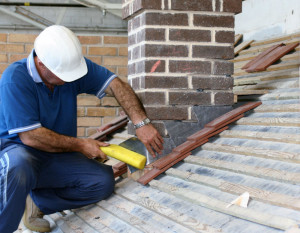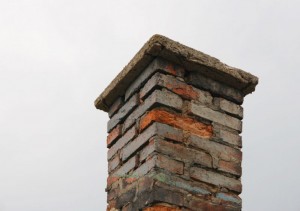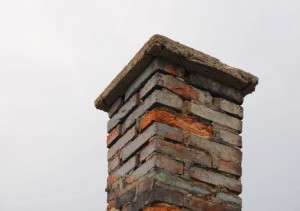Spring has finally arrived; with increasingly warm temperatures outside, most homeowners have already stopped using their fireplaces for the season. However, it is important not to neglect your fireplace until the first cold snap of fall. Instead, have chimney repairs addressed now to ensure your fireplace will be ready to use next season.
What causes chimney damage?
The bricks and mortar used in chimney construction are one of the strongest and most durable building materials in the world. This makes them uniquely suited for use in chimney construction; in addition to exposure to the elements, chimneys must be able to withstand the heat and byproducts of combustion created while the fireplace is in use.
Despite their durability, there are a number of ways fireplaces can become damaged.
Common Causes of Chimney Damage
- Water
Water can be an extremely damaging force to your chimney system. Exterior masonry can crack, spall, or crumble due to long term water damage, especially when compounded with freezing temperatures in the freeze thaw cycle. Likewise, delicate interior fireplace components such as the damper or refractory bricks of the firebox are easily damaged by even small chimney leaks and water entry.
- Settling
All homes settle over time; if a fireplace system is not built on a strong foundation, this settling can cause structural damage. Cracks within the firebox, large cracks in the chimney structure, or even tilting chimneys can all be caused by settling.
- Other causes
There is no one cause of chimney damage. Chimney damage can even be caused by reroofing, painting the masonry, climbing plants, or even power washing the bricks and mortar. A chimney inspection by a certified chimney sweep is often the best way to discover chimney damage.
When should I have my chimney repaired?
If your chimney has been damaged in any way, it is important to address potential repairs as soon as possible. Delaying or putting off repairs can cause chimney damage to worsen, even to the point of affecting the safety and structural stability of the chimney.
Because it is an off season for fireplace use, spring is an excellent time to have chimney repairs completed. The following are three reasons to address your chimney repairs now.
- Fireplace use is not affected. Warm outside temperatures in the spring mean the fireplace is rarely used. Having repairs done during the spring and summer keep you from missing out on using your fireplace when you most need it.
- Shorter wait time. Fall is the busiest season for chimney sweeps as homeowners scramble to get their fireplaces repaired and ready to use. By having your chimney repairs addressed now you are more likely to avoid a long wait before your appointment – as well as be able to schedule an appointment time that is convenient for your schedule.
- Fewer delays. Some chimney repairs cannot be done when the weather is too cold; by having repairs done during the spring you can help avoid weather related delays.
If your chimney needs repairs, don’t delay; contact Jack Pixley Sweeps today to have your chimney repairs addressed as soon as possible this spring.
While a little water in your fireplace might seem like only a minor inconvenience, it can spell major trouble for your chimney system. Whether it’s a few droplets, a large puddle, or even a musty smell, the presence of water in your fireplace and chimney can cause damage to many different chimney components.
Causes of leaky chimneys
Because chimneys are complex structures with a number of different components, there is no one guaranteed cause of a leaky chimney. However, there are several common ways that water can get in; below are four of the most common causes of chimney leaks.
- Chimney cap: Chimney caps are metal covers that protect the top of the flue and keep animals, debris, and moisture out of the chimney. If a chimney cap is installed incorrectly, does not fit properly, or is damaged, water can easily enter the flue and chimney.
- Chimney crown: The chimney crown is the mortar slab that covers and seals the top of the chimney. Well-built chimney crowns are typically made of concrete or other stone to prevent the chips and cracks associated with long term exposure to the elements. Likewise, a good chimney crown should have overhangs and be slightly sloped in order to prevent water from pooling or draining directly onto the masonry of the chimney.
- Damaged masonry: Damage caused by water can cause bricks to crack and spall; not only does this let additional water into the fireplace system, but it can also affect the structural stability of the chimney structure.

- Flashing: Chimney flashing are the layered metal strips that seal the joint between the roof and the chimney structure. Flashing can lose its watertight seal due to exposure to the elements, incorrect installation, damage from storms, or if changes to the roof line are made.
Repairing a leaky chimney
The first step to fixing a leaky chimney is to identify and repair the underlying cause of the leak. A chimney inspection done by a certified chimney sweep is often the best way to uncover where water is getting into the chimney system; by fixing how the water is getting in first, you can avoid needing the same chimney repairs because of water damage again and again.
In addition to repairing your leaky chimney, preventative maintenance can be done to protect your chimney against water damage. Waterproofing is one of the best ways to protect your masonry against water entry. Our professional-grade SaverSystems sealants are specially designed to work on masonry; these sealants allow the masonry to retain its semi-porous nature, allowing gasses to pass through but preventing moisture from getting in. Water repellent sealants can even be used if your masonry already has areas of water damage!
If you have a leaky chimney, it is important to have it repaired as soon as possible. Contact the experts at Jack Pixley Sweeps today for more information on how we can fix your leaky chimney!
 Fireplaces are designed to contain heat from a roaring fire – the last thing you want to see in your fireplace is water! The presence of water in your fireplace or chimney can indicate that there is a leak somewhere in your chimney system. Likewise, water can quickly cause damage and deterioration to your entire chimney and fireplace system.
Fireplaces are designed to contain heat from a roaring fire – the last thing you want to see in your fireplace is water! The presence of water in your fireplace or chimney can indicate that there is a leak somewhere in your chimney system. Likewise, water can quickly cause damage and deterioration to your entire chimney and fireplace system.
A leaky chimney is more than just a minor annoyance. Have your leaky chimney repaired as soon as possible to avoid long term damage to your fireplace and chimney system.
What causes chimney leaks?
Because chimneys are complex structures, there are a number of places where a leak might be caused. At Jack Pixley Sweeps, our technicians are highly trained to find the source of the leak before water damage gets worse. The following are some of the most common causes of chimney leaks.
Chimney cap: Chimney caps, also known as rain covers, are designed to protect the top of the chimney against animals, debris, and water. Without a chimney cap, water from rain, ice, and snow can freely enter your chimney, damaging the interior and exterior of your chimney system.
Chimney crown: The chimney crown seals the top of the chimney around the flue as well as protects the masonry of the chimney structure. If a chimney crown is damaged, incorrectly sized, or improperly installed it can cause a variety of chimney leaks. Crowns built without a proper overhang, for example, allow water to flow directly onto the bricks of the chimney; this, in turn, causes the masonry to crack and spall, allowing more and more water in. Likewise, cracks in the chimney crown can also let water into the chimney and create leaks.
Flashing: Flashing is the watertight strip that connects the masonry of the chimney with the rest of the roofline. Flashing can easily be installed incorrectly, especially when put in by inexperienced roofers. Likewise, even correctly installed flashing can be damaged due to animals, exposure, or settling.
Without watertight flashing, homeowners may notice water leaks or stains on the walls or ceilings around the chimney structure. Many homeowners mistakenly believe it is their roof leaking when it fact the flashing has simply lost its watertight seal.
Preventing leaky chimneys
The best thing you can do to prevent a chimney leak is to have a chimney sweep and inspection performed each year. This annual maintenance ensures that your chimney remains in top condition and any damage can be fixed quickly and easily before turning into a major issue.
In addition to regular annual maintenance, homeowners can also have their masonry waterproofed. Our waterproofing products are specifically designed for use on masonry, keeping moisture out while still allowing gas to pass through.
If you are experiencing a chimney leak, don’t delay – contact Jack Pixley Sweeps today! Our expert staff can find and repair the source of the leak and get you back to enjoying your fireplace faster!
During the warm months of summer, our chimneys fade into the background of our home, used as decorations instead of as heating appliances. Because of that, many homeowners fail to complete fireplace maintenance during the spring and summer – it simply slips their minds when their fireplaces are not in use.
 When the first true cold spell of winter hits, however, many homeowners are reminded that they did not have their chimneys swept, inspected, or repaired during the summer. This creates a fall rush as the chilly weather sets in and snow begins to fall. While it’s not too late to have your chimney swept before winter truly sets in, there are limitations to which and when repairs can be made when temperatures are colder. Click here to learn more about the chimney sweeping process.
When the first true cold spell of winter hits, however, many homeowners are reminded that they did not have their chimneys swept, inspected, or repaired during the summer. This creates a fall rush as the chilly weather sets in and snow begins to fall. While it’s not too late to have your chimney swept before winter truly sets in, there are limitations to which and when repairs can be made when temperatures are colder. Click here to learn more about the chimney sweeping process.
Why is chimney maintenance important?
Having annual chimney sweeps and inspections is one of the most important things homeowners can do to prolong to life of their chimney structure. “A chimney inspection is like an annual dental check-up,” says Ashley Eldridge, Director of Education for the CSIA. “It’s preventative maintenance that helps minimize potential hazards.”
The National Fire Protection Association recommends that “Chimneys, fireplaces, and vents shall be inspected at least once a year for soundness, freedom from deposits, and correct clearances. Cleaning, maintenance, and repairs shall be done if necessary.” During a sweep and inspection, certified technicians will evaluate the overall health of your chimney, checking the accessible parts of the interior and exterior and of the chimney. Likewise, they will clean the chimney structure, removing any buildup of creosote or other debris. If any damage is found, appropriate repairs will be recommended.
Water and masonry chimneys
Although chimneys are meant to stand against the elements, they do require annual maintenance and timely repairs to continue functioning. Even well maintained chimneys suffer due to the rain, sleet, snow, ice, and frigid temperatures of Minnesota winters. In chimneys with existing deterioration, the damage is only exacerbated.
When the bricks or mortar of a chimney become cracked, water is able to seep into the masonry. The masonry will then begin to quickly deteriorate as the water in the bricks goes through the freeze/thaw process; as temperatures drop, the water in the masonry freezes and expands, further damaging the brick. When the temperature rises again, the frozen water thaws, leaving more cracks and holes for additional water to enter. This process can cause a chimney to go from having only a few small cracks to crumbling apart in only a few short years.
Because water can cause chimneys to deteriorate so quickly, it is recommended to have repairs completed as soon as possible. It is equally important to call a chimney company at the first sign of chimney trouble, whether it is a foul odor, water in the firebox, or noticeable damage to the chimney structure. Because some chimney repairs cannot be done in cold weather, it is vitally important to get repairs finished as soon as possible.
If you have questions about the health of your chimney or need to schedule repairs before the weather gets any colder, contact Jack Pixley Sweeps today!



